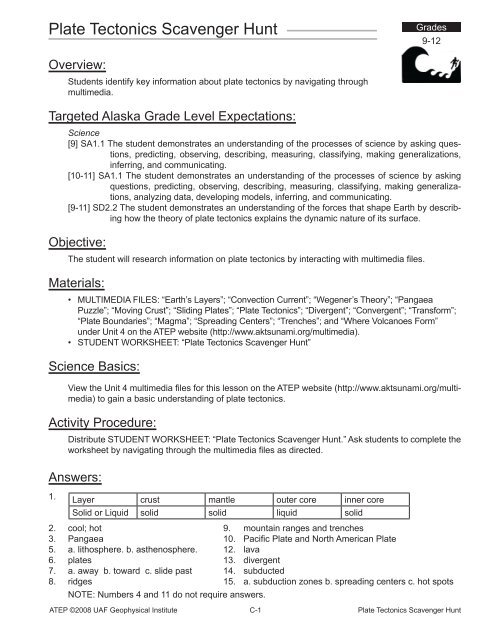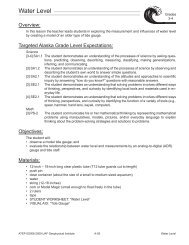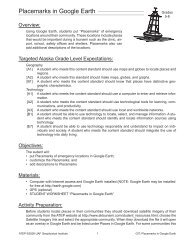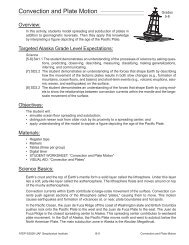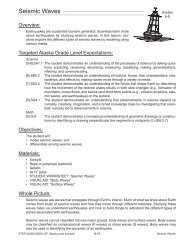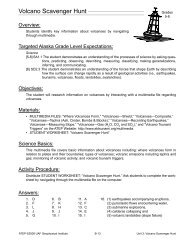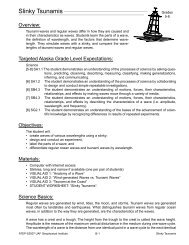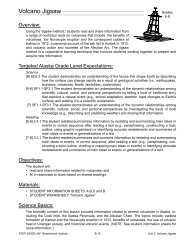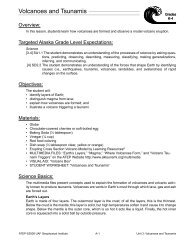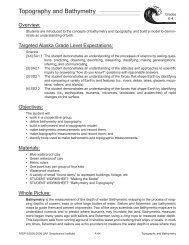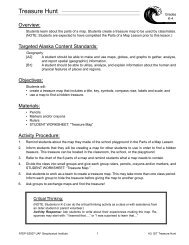Plate Tectonics Scavenger Hunt
Plate Tectonics Scavenger Hunt
Plate Tectonics Scavenger Hunt
Create successful ePaper yourself
Turn your PDF publications into a flip-book with our unique Google optimized e-Paper software.
<strong>Plate</strong> <strong>Tectonics</strong> <strong>Scavenger</strong> <strong>Hunt</strong><br />
Grades<br />
9-12<br />
Overview:<br />
Students identify key information about plate tectonics by navigating through<br />
multimedia.<br />
Targeted Alaska Grade Level Expectations:<br />
Science<br />
[9] SA1.1 The student demonstrates an understanding of the processes of science by asking questions,<br />
predicting, observing, describing, measuring, classifying, making generalizations,<br />
inferring, and communicating.<br />
[10-11] SA1.1 The student demonstrates an understanding of the processes of science by asking<br />
questions, predicting, observing, describing, measuring, classifying, making generalizations,<br />
analyzing data, developing models, inferring, and communicating.<br />
[9-11] SD2.2 The student demonstrates an understanding of the forces that shape Earth by describing<br />
how the theory of plate tectonics explains the dynamic nature of its surface.<br />
Objective:<br />
The student will research information on plate tectonics by interacting with multimedia files.<br />
Materials:<br />
• MULTIMEDIA FILES: “Earth’s Layers”; “Convection Current”; “Wegener’s Theory”; “Pangaea<br />
Puzzle”; “Moving Crust”; “Sliding <strong>Plate</strong>s”; “<strong>Plate</strong> <strong>Tectonics</strong>”; “Divergent”; “Convergent”; “Transform”;<br />
“<strong>Plate</strong> Boundaries”; “Magma”; “Spreading Centers”; “Trenches”; and “Where Volcanoes Form”<br />
under Unit 4 on the ATEP website (http://www.aktsunami.org/multimedia).<br />
• STUDENT WORKSHEET: “<strong>Plate</strong> <strong>Tectonics</strong> <strong>Scavenger</strong> <strong>Hunt</strong>”<br />
Science Basics:<br />
View the Unit 4 multimedia files for this lesson on the ATEP website (http://www.aktsunami.org/multimedia)<br />
to gain a basic understanding of plate tectonics.<br />
Activity Procedure:<br />
Distribute STUDENT WORKSHEET: “<strong>Plate</strong> <strong>Tectonics</strong> <strong>Scavenger</strong> <strong>Hunt</strong>.” Ask students to complete the<br />
worksheet by navigating through the multimedia files as directed.<br />
Answers:<br />
1.<br />
Layer crust mantle outer core inner core<br />
Solid or Liquid solid solid liquid solid<br />
2. cool; hot 9. mountain ranges and trenches<br />
3. Pangaea 10. Pacific <strong>Plate</strong> and North American <strong>Plate</strong><br />
5. a. lithosphere. b. asthenosphere. 12. lava<br />
6. plates 13. divergent<br />
7. a. away b. toward c. slide past 14. subducted<br />
8. ridges 15. a. subduction zones b. spreading centers c. hot spots<br />
NOTE: Numbers 4 and 11 do not require answers.<br />
ATEP ©2008 UAF Geophysical Institute C-1 <strong>Plate</strong> <strong>Tectonics</strong> <strong>Scavenger</strong> <strong>Hunt</strong>
Name:____________________________________<br />
<strong>Plate</strong> <strong>Tectonics</strong> <strong>Scavenger</strong> <strong>Hunt</strong><br />
Student Worksheet (page 1 of 2)<br />
Grades<br />
9-12<br />
Directions: View the multimedia files in Unit 4 from the ATEP website: http://www.aktsunami.org/<br />
multimedia. Check off each multimedia file you view, and complete each statement or task.<br />
1. q Earth’s Layers<br />
Name the four layers of Earth and classify each one as solid or liquid.<br />
Layer<br />
Solid or Liquid<br />
2. q Convection Current<br />
In the convection currents inside Earth, _____________________________ material sinks and<br />
______________________________ material is pushed upward.<br />
3. q Wegener’s Theory<br />
The name of the supercontinent in Alfred Wegener’s theory is _____________________________.<br />
4. q Pangaea Puzzle<br />
5. q Moving Crust<br />
a. The solid layer formed by Earth’s crust and the top of the mantle is the ____________________.<br />
b. The soft, jelly-like layer of the mantle is the _________________________________________.<br />
6. q Sliding <strong>Plate</strong>s<br />
Convection currents break the lithosphere into pieces called ______________________________.<br />
7. q <strong>Plate</strong> <strong>Tectonics</strong><br />
Name the three ways plates may move at their boundaries.<br />
a. ______________________ b. ______________________ c. ______________________<br />
ATEP ©2008 UAF Geophysical Institute C-2 <strong>Plate</strong> <strong>Tectonics</strong> <strong>Scavenger</strong> <strong>Hunt</strong>
Name:____________________________________<br />
<strong>Plate</strong> <strong>Tectonics</strong> <strong>Scavenger</strong> <strong>Hunt</strong><br />
Student Worksheet (page 2 of 2)<br />
Grades<br />
9-12<br />
8. q Divergent<br />
What type of landform forms at divergent boundaries on oceanic crust? ______________________<br />
9. q Convergent<br />
What two types of landforms form at convergent boundaries?<br />
_____________________________________ and ______________________________________<br />
10. q Transform<br />
Which two plates slide past each other on the San Andreas Fault?<br />
_____________________________________ and ______________________________________<br />
11. q <strong>Plate</strong> Boundaries<br />
12. q Magma<br />
When it reaches Earth’s surface, magma is called ______________________________________.<br />
13. q Spreading Centers<br />
Midocean ridges form at ___________________________ plate boundaries. These form new<br />
ocean floor.<br />
14. q Trenches<br />
Old ocean floor is _______________________________ or pushed down into trenches.<br />
15. q Where Volcanoes Form<br />
Where do volcanoes form?<br />
a. ______________________ b. ______________________ c. ______________________<br />
ATEP ©2008 UAF Geophysical Institute C-3 <strong>Plate</strong> <strong>Tectonics</strong> <strong>Scavenger</strong> <strong>Hunt</strong>


